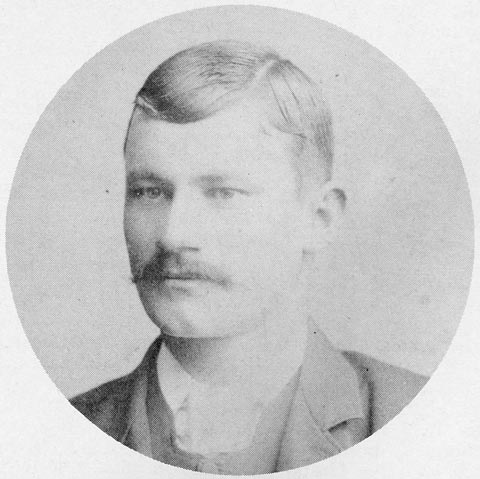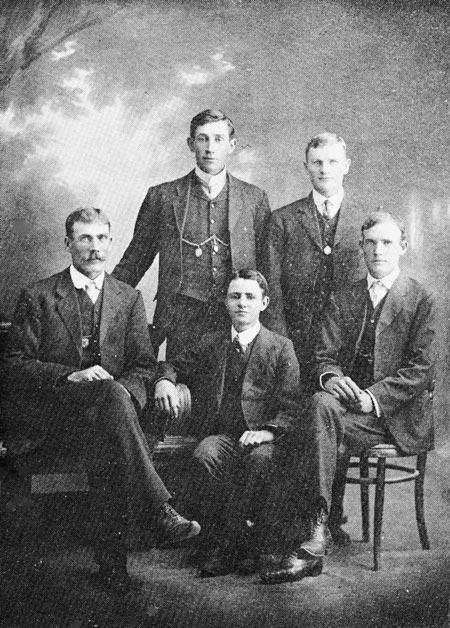A Centenary of Rowing Regattas— Murray Rowing Association
Table of Contents
Introduction- A Hectic Birth
- Early Years on the Lake
- Maturity and Its Problems
- Early Years of Amateur Status
- 1911 Jubilee Regatta
- The Lost Years and Thereafter
- An Explanation
Appendices
- Grand Challenge Races
- 1873 Programme
- Regatta Day by Keith Cammeron
- Grand Challenge Fours Winners
- Presidents
- Conclusion
Photo galleries
4. Early Years of Amateur Status
1891 saw the last professional Regatta, when the Lake Moodemere crew again won the Challenge Cup. In previous years, an occasional race for amateur crews had been included in the programme, but in this year the problem of amateur status became prominent. Corowa and Williamstown had amateur crews present, but as prizes were cash, they could not compete. The original professional form of the Regatta excluded all Melbourne Clubs from competing, because they came under the amateur rules of the Victorian Rowing Association and could only accept trophies as prizes. Due to the lack of support for this 1891 Regatta by local Clubs, the Regatta Committee decided to investigate the possibility of becoming affiliated with the V.R.A.
A Letter in reply from the V.R.A. Secretary, W. B. House stated that his Committee were prepared to accept the local oarsmen as amateurs, provided that they now competed for trophies only.
A motion was moved by Mr. T. Drenen, seconded by Mr. Jackson, that a rowing association be formed under rules similar to the V.R.A. Thus the Murray Rowing Association came into existence.

J. NUGENT, Founder of the Wahgunyah
Rowing Club, and well-known Coach.
The programme, for the first Moodemere Regatta to be held under Amateur rules (1892) stated that Pair-Oared races had to continue to be rowed in four-oared boats which were to be "test gigs" (or "open string test gigs" to give them their full title as used in Appendix 2, Rule 16). These gigs were a rowing shell with fixed poppet rowlocks and to comply with the string test the boat should allow a string to be passed beneath the hull from rowlock to rowlock, touching the hull all the way.
The seating arrangement became obviously staggered as can be seen by looking closely at the photograph on page 8, and the beam of the boat was thus naturally wider than that of an outrigger craft where the point of leverage was extended beyond the side of the boat. To row a pair-oared race in a four-oared gig, one man took the bow seat and the other the stroke seat.
(Note: A pair-oared gig of a date later than the first amateur Regatta on Lake Moodemere is on display at this Centenary Regatta).
In Melbourne before 1860, the Regattas were mostly rowed in gigs, but at the first Melbourne Regatta, three four-oared outriggers took part and this form of boat quickly gained popularity among amateurs until the last gig race at a Melbourne Regatta was rowed in 1894. The keelless boats were first used at Henley in England in 1856, and the sliding seat was introduced in the 1870's, quickly being brought into general use in Australia within a decade. These two modifications could be applied to gigs as well as outriggers, but the swivel rowlock, although used in sculling boats in Australia by the late 1870's was found unsatisfactory or unpopular when used on gig fours. For amateur status, the Lake Moodemere course was surveyed with a peg turn during 1891, and the course then measured one mile, 100 yards compared with the old professional course which was about 400 yards longer. because it entailed a turn around an island. It was this peg turn which allowed gigs to maintain their popularity with Clubs in this district up to the 1920's. As explained in the "Corowa Free Press" during 1907, outriggers were not regarded as suitable for the Lake Moodemere course, being unable to turn quickly at the peg for the return leg of a race.
In 1897, the "Corowa Free Press" claimed that if races were rowed in outrigger boats instead of gigs, more metropolitan Clubs would compete. Therefore 1898. Pair-oared and Four-oared events for outriggers were included in the Regatta programme, and two Melbourne crews from Yarra Yarra and Electric Telegraphs attended to compete in these events. Other Melbourne crews did occasionally attend Regattas by the turn of the Century, but with transport difficulties they would borrow local boats for use in events.
It was only during the 1920's, that the change of in type of boats took place in this district. Mr. Kenny, Secretary of the V.R.A. and President of the Australian Rowing Council, attended an M.R.A. meeting and persuaded Clubs of the local Association to change to outrigger racing.

Well known Rutheglen Lake crew - The four Jackson brothers, second generation of the famous rowing family
Back row: Lou Jackson, Mick O'Donoghue, Hal Jackson, Lyn Jackson. Front: Bert Jackson
